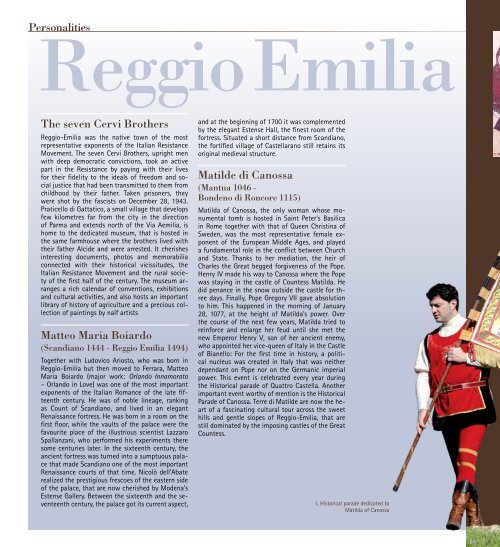of Emilia Romagna
of Emilia Romagna
of Emilia Romagna
You also want an ePaper? Increase the reach of your titles
YUMPU automatically turns print PDFs into web optimized ePapers that Google loves.
Personalities<br />
Reggio <strong>Emilia</strong><br />
The seven Cervi Brothers<br />
Reggio-<strong>Emilia</strong> was the native town <strong>of</strong> the most<br />
representative exponents <strong>of</strong> the Italian Resistance<br />
Movement. The seven Cervi Brothers, upright men<br />
with deep democratic convictions, took an active<br />
part in the Resistance by paying with their lives<br />
for their fidelity to the ideals <strong>of</strong> freedom and social<br />
justice that had been transmitted to them from<br />
childhood by their father. Taken prisoners, they<br />
were shot by the fascists on December 28, 1943.<br />
Praticello di Gattatico, a small village that develops<br />
few kilometres far from the city in the direction<br />
<strong>of</strong> Parma and extends north <strong>of</strong> the Via Aemilia, is<br />
home to the dedicated museum, that is hosted in<br />
the same farmhouse where the brothers lived with<br />
their father Alcide and were arrested. It cherishes<br />
interesting documents, photos and memorabilia<br />
connected with their historical vicissitudes, the<br />
Italian Resistance Movement and the rural society<br />
<strong>of</strong> the first half <strong>of</strong> the century. The museum arranges<br />
a rich calendar <strong>of</strong> conventions, exhibitions<br />
and cultural activities, and also hosts an important<br />
library <strong>of</strong> history <strong>of</strong> agriculture and a precious collection<br />
<strong>of</strong> paintings by naïf artists<br />
Matteo Maria Boiardo<br />
(Scandiano 1444 - Reggio <strong>Emilia</strong> 1494)<br />
Together with Ludovico Ariosto, who was born in<br />
Reggio-<strong>Emilia</strong> but then moved to Ferrara, Matteo<br />
Maria Boiardo (major work: Orlando Innamorato<br />
– Orlando in Love) was one <strong>of</strong> the most important<br />
exponents <strong>of</strong> the Italian Romance <strong>of</strong> the late fifteenth<br />
century. He was <strong>of</strong> noble lineage, ranking<br />
as Count <strong>of</strong> Scandiano, and lived in an elegant<br />
Renaissance fortress. He was born in a room on the<br />
first floor, while the vaults <strong>of</strong> the palace were the<br />
favourite place <strong>of</strong> the illustrious scientist Lazzaro<br />
Spallanzani, who performed his experiments there<br />
some centuries later. In the sixteenth century, the<br />
ancient fortress was turned into a sumptuous palace<br />
that made Scandiano one <strong>of</strong> the most important<br />
Renaissance courts <strong>of</strong> that time. Nicolò dell’Abate<br />
realized the prestigious frescoes <strong>of</strong> the eastern side<br />
<strong>of</strong> the palace, that are now cherished by Modena’s<br />
Estense Gallery. Between the sixteenth and the seventeenth<br />
century, the palace got its current aspect,<br />
and at the beginning <strong>of</strong> 1700 it was complemented<br />
by the elegant Estense Hall, the finest room <strong>of</strong> the<br />
fortress. Situated a short distance from Scandiano,<br />
the fortified village <strong>of</strong> Castellarano still retains its<br />
original medieval structure.<br />
Matilde di Canossa<br />
(Mantua 1046 -<br />
Bondeno di Roncore 1115)<br />
Matilda <strong>of</strong> Canossa, the only woman whose monumental<br />
tomb is hosted in Saint Peter’s Basilica<br />
in Rome together with that <strong>of</strong> Queen Christina <strong>of</strong><br />
Sweden, was the most representative female exponent<br />
<strong>of</strong> the European Middle Ages, and played<br />
a fundamental role in the conflict between Church<br />
and State. Thanks to her mediation, the heir <strong>of</strong><br />
Charles the Great begged forgiveness <strong>of</strong> the Pope.<br />
Henry IV made his way to Canossa where the Pope<br />
was staying in the castle <strong>of</strong> Countess Matilda. He<br />
did penance in the snow outside the castle for three<br />
days. Finally, Pope Gregory VII gave absolution<br />
to him. This happened in the morning <strong>of</strong> January<br />
28, 1077, at the height <strong>of</strong> Matilda’s power. Over<br />
the course <strong>of</strong> the next few years, Matilda tried to<br />
reinforce and enlarge her feud until she met the<br />
new Emperor Henry V, son <strong>of</strong> her ancient enemy,<br />
who appointed her vice-queen <strong>of</strong> Italy in the Castle<br />
<strong>of</strong> Bianello: For the first time in history, a political<br />
nucleus was created in Italy that was neither<br />
dependant on Pope nor on the Germanic imperial<br />
power. This event is celebrated every year during<br />
the Historical parade <strong>of</strong> Quattro Castella. Another<br />
important event worthy <strong>of</strong> mention is the Historical<br />
Parade <strong>of</strong> Canossa. Terre di Matilde are now the heart<br />
<strong>of</strong> a fascinating cultural tour across the sweet<br />
hills and gentle slopes <strong>of</strong> Reggio-<strong>Emilia</strong>, that are<br />
still dominated by the imposing castles <strong>of</strong> the Great<br />
Countess.<br />
1. Historical parade dedicated to<br />
Matilda <strong>of</strong> Canossa
















